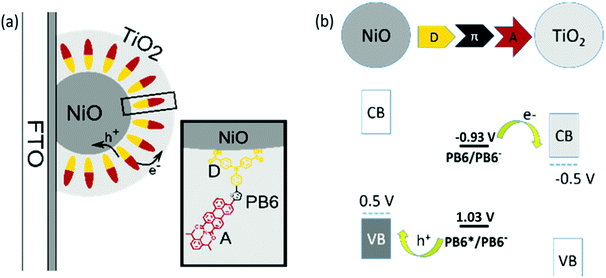 Open Access Article
Open Access ArticleCreative Commons Attribution 3.0 Unported Licence
Correction: Ultrafast dye regeneration in a core–shell NiO–dye–TiO2 mesoporous film
Lei
Tian
a,
Jens
Föhlinger
a,
Palas Baran
Pati
a,
Zhibin
Zhang
b,
Junzhong
Lin
c,
Wenxing
Yang
a,
Malin
Johansson
a,
Tomas
Kubart
b,
Junliang
Sun
c,
Gerrit
Boschloo
a,
Leif
Hammarström
*a and
Haining
Tian
*a
aDepartment of Chemistry-Ångström Laboratories, Uppsala University, Box 523, SE75120 Uppsala, Sweden. E-mail: haining.tian@kemi.uu.se
bDepartment of Engineering Sciences, Uppsala University, Box 534, SE75120 Uppsala, Sweden
cDepartment of Materials and Environmental Chemistry, Stockholm University, 106 91 Stockholm, Sweden
First published on 15th November 2018
Abstract
Correction for ‘Ultrafast dye regeneration in a core–shell NiO–dye–TiO2 mesoporous film’ by Lei Tian et al., Phys. Chem. Chem. Phys., 2018, 20, 36–40.
There was an error in the value of the transition energy (E0–0) for the PB6 dye on the electrode, which should be 1.96 eV instead of 2.14 eV. E(PB6*/PB6−) is therefore changed to 1.03 V vs. NHE accordingly.
The following figure should be substituted for the incorrect Fig. 1:
The following changes should be made accordingly on page 37, 6th paragraph: “The obtained energy alignment indicated that the hole (ΔG0 = −530 mV) and electron injection (ΔG0 = −430 mV) into the NiO valence band (VB) and the TiO2 conduction band (CB), respectively, from the excited PB6 (E0–0 = 1.96 eV) were thermodynamically favorable, as indicated in Fig. 1b and Table S1 (ESI†).”
Table S1 in the supporting information has been updated accordingly.
These changes do not influence the method used and the conclusions reported in this work.
Acknowledgements
The author is grateful to Dr Bo Xu from Uppsala University for pointing out the above error.The Royal Society of Chemistry apologises for these errors and any consequent inconvenience to authors and readers.
| This journal is © the Owner Societies 2018 |

